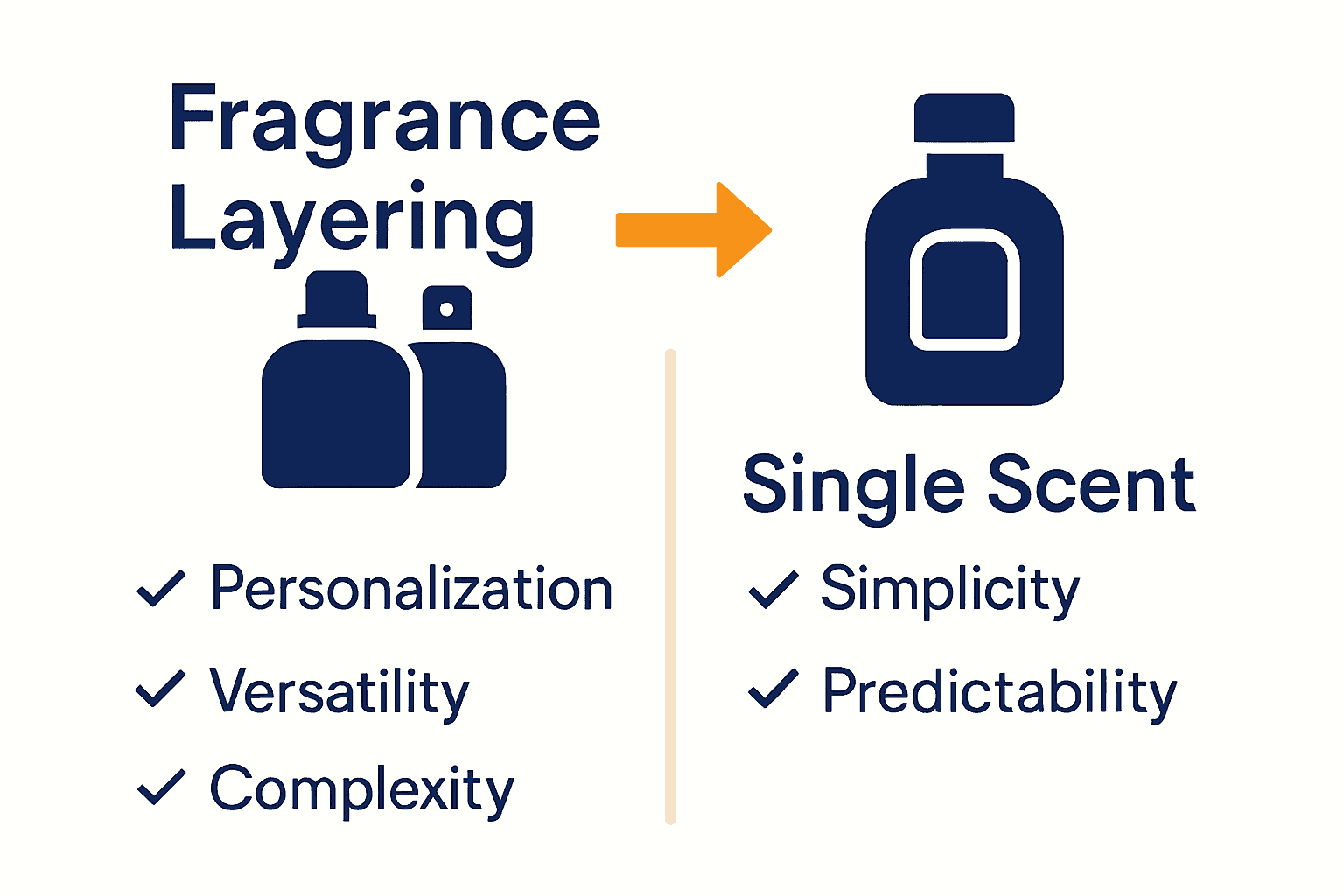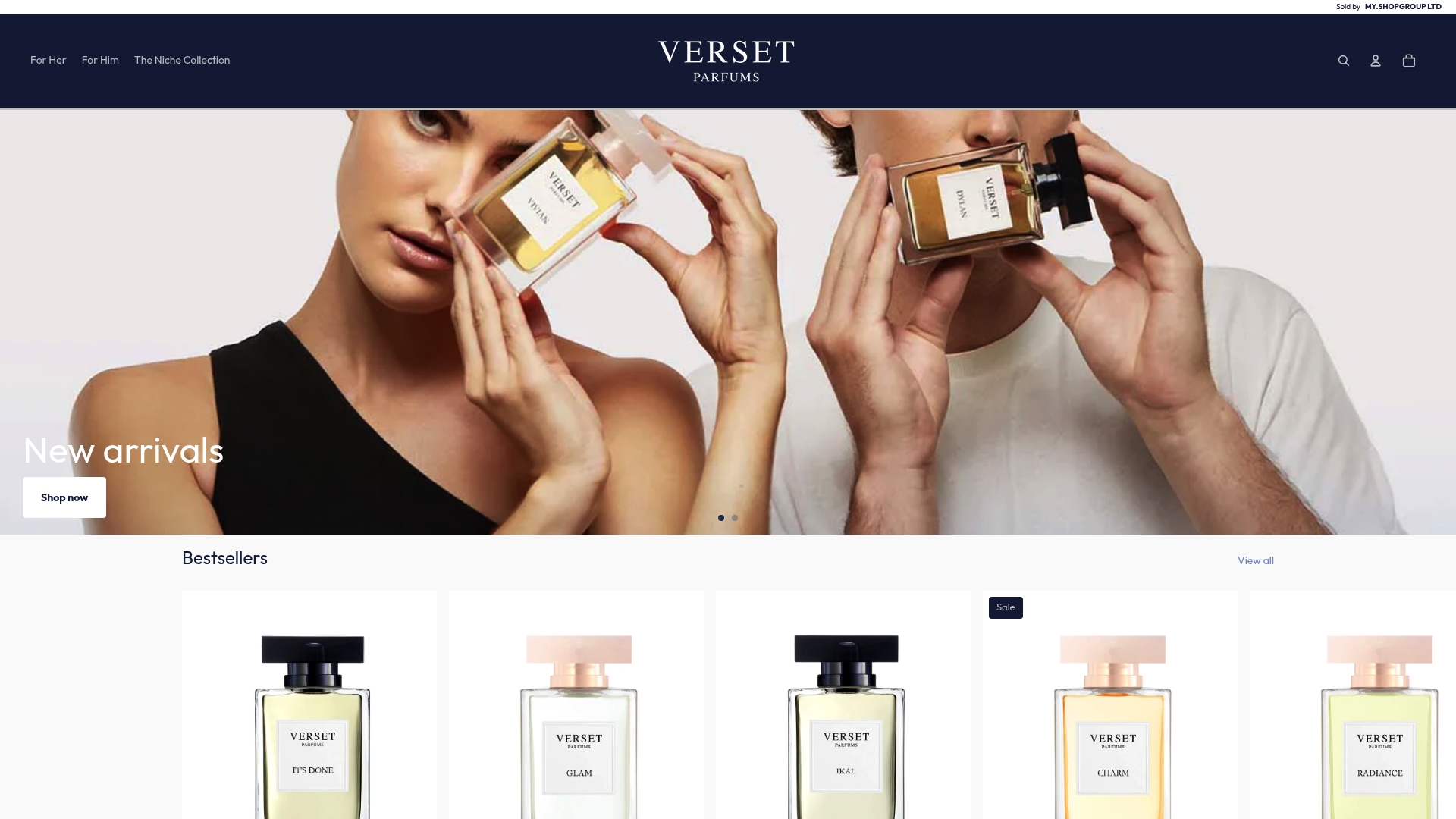Did you know that over 70 percent of perfume lovers have tried mixing two or more scents at home? Many believe fragrance layering is only for experts or those with massive collections, yet even beginners can build unique aromas with just a few bottles. Understanding how perfumes interact can turn a daily routine into an adventure, letting you express style and mood in a way that no single fragrance can achieve.
Table of Contents
- Defining Fragrance Layering And Common Myths
- Types Of Fragrance Layering Techniques
- Selecting Scents For Effective Layering
- Step-By-Step Guide To Layering Perfumes
- Benefits Of Layering Versus Single Scents
- Common Mistakes And How To Avoid Them
Key Takeaways
| Point | Details |
|---|---|
| Fragrance Layering | A technique for personalizing scents by combining multiple fragrances for a unique profile. |
| Complementary Layering | Best for beginners, it involves blending similar fragrance families for harmonious scents. |
| Avoid Common Mistakes | Start with the strongest scent and layer lighter fragrances, and be mindful of personal chemistry. |
| Benefits of Layering | Allows for personalization, versatility, and cost-effectiveness in creating a signature scent. |
Defining Fragrance Layering and Common Myths
Fragrance layering is a sophisticated technique that transforms your perfume experience from mundane to extraordinary, allowing you to create personalised scent profiles that are uniquely yours. According to Vogue, a common myth is that fragrance layering requires extensive knowledge or an enormous perfume collection. In reality, even fragrance novices can successfully experiment by combining two complementary scents.
At its core, fragrance layering involves strategically applying multiple perfumes or scented products to develop a more complex, nuanced aroma. Think of it like creating a culinary masterpiece - just as chefs blend different ingredients to create something extraordinary, perfume enthusiasts mix fragrances to craft a signature scent. The key is understanding how different fragrance notes interact and complement each other.

For those looking to master this art, consider these fundamental principles:
- Start with lighter, more delicate fragrances as base layers
- Experiment with scents from similar fragrance families
- Apply fragrances to pulse points for optimal diffusion
- Begin with small quantities and gradually build complexity
While some might find fragrance layering intimidating, our guide on understanding fragrance notes can help demystify the process. With practice and curiosity, anyone can develop their personal scent alchemy, transforming everyday perfume application into a creative expression of personal style.
Types of Fragrance Layering Techniques
Fragrance layering is an art form that goes beyond simply applying multiple scents. Professional perfume enthusiasts have developed several sophisticated techniques to create unique and complex fragrance experiences. Understanding these methods can help you transform your personal scent profile from ordinary to extraordinary.
Complementary Layering represents the most approachable technique for beginners. This method involves selecting fragrances that share similar fragrance families or complementary notes. For instance, pairing a woody base with a citrusy top note can create a harmonious and intriguing scent combination. When exploring how to build a fragrance collection, consider fragrances that naturally enhance each other’s characteristics.
Here are the primary fragrance layering techniques:
Here’s a comparison of the main fragrance layering techniques:
| Technique | Description | Best For |
|---|---|---|
| Complementary Layering | Blending similar or harmonious fragrance families | Beginners |
| Base and Top Note Layering | Lighter fragrance over richer base notes | Everyday versatility |
| Seasonal Layering | Adjusting scents by climate or weather | Adapting to environment |
| Intensity Gradient Layering | Applying from lightest to most concentrated scents | Long-lasting complexity |
-
Complementary Layering: Blending scents from similar fragrance families
-
Base and Top Note Layering: Using lighter fragrances over richer base scents
-
Seasonal Layering: Adjusting fragrance combinations based on temperature and climate
-
Intensity Gradient Layering: Applying fragrances from lightest to most concentrated
Advanced practitioners often experiment with more complex approaches, such as creating multi-dimensional scent profiles by strategically applying fragrances to different pulse points. This technique allows for a dynamic scent experience that evolves throughout the day, revealing different olfactory nuances as your body heat interacts with the perfume. For those eager to dive deeper into understanding the intricate world of fragrances, exploring examples of fragrance notes can provide valuable insights into crafting your signature scent.
Selecting Scents for Effective Layering
Mastering the art of fragrance layering requires a nuanced understanding of scent composition and complementary notes. Fragrance selection is crucial to creating a harmonious and sophisticated personal scent profile that evolves beautifully throughout the day.
According to IPSY Blog, when selecting scents for layering, professionals recommend starting with base notes like vanilla or sandalwood, which provide a lasting foundation. These rich, deep notes create a warm backdrop for more dynamic and lighter fragrance elements. By strategically building your scent from the bottom up, you can craft a multi-dimensional aromatic experience that tells a unique olfactory story.
Key considerations when selecting fragrances for layering include:
- Complementary Fragrance Families: Choose scents that share similar molecular structures
- Intensity Balance: Pair stronger scents with more delicate fragrances
- Seasonal Appropriateness: Select notes that harmonize with current weather and temperature
- Personal Chemistry: Consider how different fragrances interact with your individual body chemistry
For those looking to refine their fragrance selection skills, fragrance shopping insights can provide additional guidance. Remember, successful fragrance layering is part science, part art – it requires experimentation, patience, and a willingness to explore your unique sensory landscape.
Step-By-Step Guide to Layering Perfumes
Fragrance layering is an intricate process that transforms simple perfume application into a personalized sensory experience. Mastering this technique requires patience, creativity, and a strategic approach to combining scents that complement and enhance one another.
According to Memo Paris, the fundamental technique begins by applying heavier scents, typically woody or oriental eau de parfum, to pulse points. When layering, it’s crucial to pay close attention to fragrance notes to ensure compatibility and start with minimal quantities to prevent overwhelming the senses.
Here’s a comprehensive step-by-step method for successful fragrance layering:
- Prepare Your Skin: Start with clean, moisturized skin to help fragrances adhere better
- Choose Your Base: Select a rich, long-lasting fragrance as your foundational scent
- Add Complementary Layers: Introduce lighter, more dynamic fragrances on top of the base
- Apply to Pulse Points: Focus on areas like wrists, neck, and behind ears for optimal diffusion
- Allow Settling Time: Wait a few minutes between layers to let each scent develop
For those seeking expert guidance on perfume application, our tutorial on applying fragrance for lasting scents can provide additional insights. Remember, fragrance layering is an art form – each combination is a unique expression of your personal style and olfactory preferences.
Benefits of Layering Versus Single Scents
Fragrance layering represents a sophisticated approach to personal scent expression that transcends traditional perfume application. While single scents offer simplicity, layered fragrances provide a dynamic, multi-dimensional olfactory experience that adapts to individual personalities and contexts.
According to The Frisky, layering perfumes enables individuals to create a unique, personalized scent that reflects individual preferences and moods. This technique offers unparalleled flexibility, allowing fragrance enthusiasts to adapt their scents for different occasions or seasons by strategically combining complementary fragrances.

Key advantages of fragrance layering include:
- Personalization: Craft a signature scent that is entirely unique to you
- Versatility: Adjust fragrance intensity and character based on context
- Complexity: Create multi-dimensional scent profiles that evolve throughout the day
- Cost-Effectiveness: Maximize existing perfume collection without purchasing new fragrances
- Sensory Expression: Communicate mood and personality through nuanced scent combinations
For those seeking to expand their fragrance horizons, our guide to mastering fragrance selection can provide additional insights into developing a sophisticated scent strategy. Remember, fragrance layering is an art form that invites creativity, experimentation, and personal exploration.
Common Mistakes and How to Avoid Them
Fragrance layering might seem straightforward, but numerous subtle pitfalls can transform a potentially exquisite scent experience into an olfactory disaster. Mastering this delicate art requires understanding the nuanced interactions between different perfume compositions and your individual body chemistry.
According to LuxPlus, one critical mistake is applying the strongest perfume last, which can completely overpower other scents. Professionals recommend starting with the strongest fragrance and layering lighter scents on top, ensuring each individual note has an opportunity to shine and develop harmoniously.
Common fragrance layering mistakes to avoid include:
- Overwhelming Combinations: Mixing too many competing scent profiles
- Ignoring Fragrance Families: Combining incompatible molecular structures
- Applying Too Much: Using excessive quantities that muddle individual notes
- Neglecting Body Chemistry: Failing to consider how fragrances interact with personal skin type
- Rushing the Process: Not allowing sufficient time between layering applications
For fragrance enthusiasts seeking to refine their technique, our guide to applying fragrance for lasting scents offers additional expert insights. Remember, perfume layering is an art of subtlety, patience, and continuous experimentation.
Discover Your Signature Scent Through Fragrance Layering with Verset Parfums
If you have been intrigued by the art of fragrance layering but feel overwhelmed by where to start or how to choose the perfect combination, you are not alone. This expert guide highlighted how layering intensifies personal expression with complementary scents and careful selection of fragrance notes. At the heart of this technique is a desire for a unique, sophisticated aroma that evolves beautifully throughout the day.

Explore our curated collection at Verset Parfums designed precisely with layering in mind. Each fragrance draws inspiration from luxurious designer scents yet remains accessible and crafted to high European standards. Whether you prefer rich woody bases or lighter citrus tops, our range lets you experiment freely to create your signature blend. Browse our Niche Perfumes for unique combinations or our Best Sellers to find trusted favourites. Start your sensory journey today at https://versetparfums.shop and transform layering from a challenge into your greatest aromatic expression.
Frequently Asked Questions
What is fragrance layering?
Fragrance layering is a technique that involves applying multiple perfumes or scented products in a strategic manner to create a unique and personalized scent profile. It allows individuals to enhance their olfactory experience and express their personal style.
How can I start fragrance layering as a beginner?
To begin fragrance layering, start with complementary scents from similar fragrance families. Use lighter fragrances as base layers and apply them to pulse points like wrists and neck to optimize diffusion. Experiment with small quantities first.
What are some common mistakes to avoid in fragrance layering?
Common mistakes include overwhelming combinations of competing scents, applying the strongest perfume last, and using excessive amounts of fragrance that muddle individual notes. It’s also essential to consider how fragrances interact with your personal body chemistry.
What are the benefits of fragrance layering compared to using single scents?
Fragrance layering offers personalization, versatility, and complexity, allowing individuals to create a unique scent that reflects their personality. It also helps maximize existing perfume collections, enabling users to adjust their scents for different occasions without purchasing new fragrances.
Recommended
- Understanding the Role of Fragrance Notes in Perfumes – VersetParfums.Shop
- 7 Examples of Fragrance Notes to Enhance Your Perfume Collection – VersetParfums.Shop
- How to Apply Fragrance for Lasting Luxury Scents – VersetParfums.Shop
- Fragrance Shopping Explained: Understanding Scents and Choices – VersetParfums.Shop








0 comments